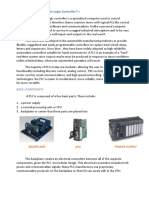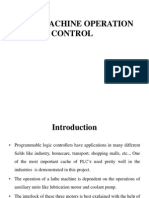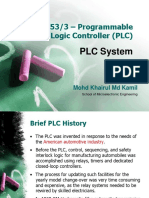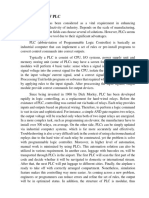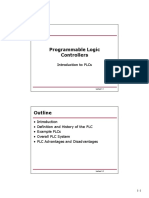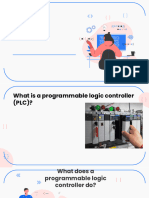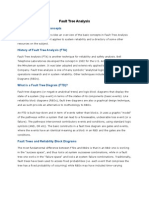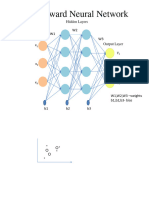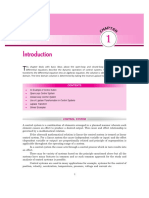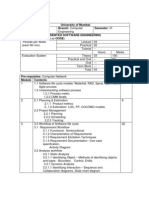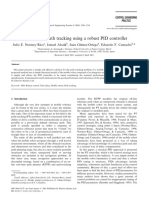Programmable Logic Controller
Programmable Logic Controller
Uploaded by
Black PigeonCopyright:
Available Formats
Programmable Logic Controller
Programmable Logic Controller
Uploaded by
Black PigeonCopyright
Available Formats
Share this document
Did you find this document useful?
Is this content inappropriate?
Copyright:
Available Formats
Programmable Logic Controller
Programmable Logic Controller
Uploaded by
Black PigeonCopyright:
Available Formats
PROGRAMMABLE LOGIC CONTROLLER (PLC) Programmable logic control or PLC is the most commonly used industrial automation technique
in the world. It is universally applied for factory automation, process control and manufacturing systems. Programmable logic control originated from the creation of computerized versions of relay control systems used to control manufacturing and chemical process systems. The programming is done using a special technique called ladder logic, which allows sequences of logical actions to be set up, inter-linked and timed. A standard task in logic control is batch control and sequencing in a process system. PLC INTRODUCTION A PLC or Programmable Logic Controller is a user friendly, microprocessor specialized computer that carries out control functions of many types and levels of complexity. Its purpose is to monitor crucial process parameters and adjust process operations accordingly. It can be programmed, controlled and operated by a person unskilled in operating computers. Essentially, a PLC's operator draws the lines and devices of ladder diagrams with a keyboard onto a display screen. The resulting drawing is converted into computer machine language and run as a user program. PLC will operate any system that has output devices that go on and off (Discrete, or Digital, outputs). It can also operate any system with variable (analog) outputs. The Programmable Logic Control can be operated on the input side by ON/OFF devices or by variable (analog) input devices. Control engineering has evolved over time. In the past humans was the main method for controlling a system. More recently electricity has been used for control and early electrical control was based on relays. These relays allow power to be switched on and off without a mechanical switch. It is common to use relays to make simple logical control decisions. The development of low cost computer has brought the most recent revolution, the Programmable Logic Controller (PLC). The advent of the PLC began in the 1970s, and has become the most common choice for manufacturing controls. Programmable Logic Controllers have been gaining popularity on the factory floor and will probably remain predominant for some time to come. Most of this is because of the advantages they offer.
PLC ADVANTAGES
Flexibility: One single Programmable Logic Controller can easily run many machines. Correcting Errors: In old days, with wired relay-type panels, any program alterations required time for rewiring of panels and devices. With PLC control any change in circuit design or sequence is as simple as retyping the logic. Correcting errors in PLC is extremely short and cost effective.
Space Efficient: Today's Programmable Logic Control memory is getting bigger and bigger this means that we can generate more and more contacts, coils, timers, sequencers, counters and so on. We can have thousands of contact timers and counters in a single PLC. Imagine what it would be like to have so many things in one panel.
Low Cost: Prices of Programmable Logic Controlers vary from few hundreds to few thousands. This is nothing compared to the prices of the contact and coils and timers that you would pay to match the same things. Add to that the installation cost, the shipping cost and so on.
Testing: A Programmable Logic Control program can be tested and evaluated in a lab. The program can be tested, validated and corrected saving very valuable time. Visual observation: When running a PLC program a visual operation can be seen on the screen. Hence troubleshooting a circuit is really quick, easy and simple.
PLC DISADVANTAGE 1. Because it is a new technology, so that should require training. 2. Some applications that perform a single function, is not efficient in the use of PLC. 3. Limited usage environments, high temperatures and harsh vibrations can disrupt electronic equipment on the PLC. 4. Need extra security equipment such as really. 5. PLC is not considered necessary when applied to industrial systems that do not need to change the wiring
PROGRAMMABLE LOGIC CONTROLLER, PLC For this mechanical relay we use UR1 Substrate 18 trough, part no. 6ES7-400-1TA01-0AA for PLC the price is RM 2946.72. Please refer at the appendixes for product view. Repair per year (twice) = RM 4410 Energy consumption per month, 100 watt = RM0.40 1200 watt x RM0.40 = RM480
Cost per month = RM 480
Cost per year = RM 480 + RM4410 = RM 4890 Total cost per year = RM2946.72+ RM 4890 = RM 7836.72
APPENDIX
UR1 Substrate 18 trough, part no. 6ES7-400-1TA01-0AA
PRODUCT OUTPUT
CANT DECIDE UNTIL THE CIRCUIT IS DONE!!!!!
You might also like
- PLC Programming For Industrial ApplicationsDocument20 pagesPLC Programming For Industrial Applicationssayyan50% (2)
- PLC in Industrial Control: Ing. Marie Martinásková, Ph.D. Ing. Jakub JURADocument65 pagesPLC in Industrial Control: Ing. Marie Martinásková, Ph.D. Ing. Jakub JURAAllan CorreaNo ratings yet
- Training Program On Programmable Logic ControllerDocument28 pagesTraining Program On Programmable Logic ControllerHimanish GuptaNo ratings yet
- Complete Report1 PLCDocument90 pagesComplete Report1 PLCRao Arslan Rajput100% (3)
- PLC and Scada Systems: Programmable Logic Controller Supervisory Control and Data AcquisitionDocument35 pagesPLC and Scada Systems: Programmable Logic Controller Supervisory Control and Data AcquisitionjustinkikoNo ratings yet
- What Is Programmable Logic ControllerDocument4 pagesWhat Is Programmable Logic ControllerNgwe Soe HanNo ratings yet
- Introduction To Robotics (Lab) : K. Menaka ThathsaranaDocument27 pagesIntroduction To Robotics (Lab) : K. Menaka ThathsaranaUditha MuthumalaNo ratings yet
- 11.lathe Machine Operation ControlDocument15 pages11.lathe Machine Operation ControlVijay Vijju SaradhyNo ratings yet
- Industrial Training: Submitted For Partial Fulfillment of Award of B.Tech DegreeDocument35 pagesIndustrial Training: Submitted For Partial Fulfillment of Award of B.Tech DegreeNeha DhanukaNo ratings yet
- Fdocuments - in - Training Report On PLC ScadaDocument40 pagesFdocuments - in - Training Report On PLC Scadaabloft Off page100% (1)
- Lect 001Document18 pagesLect 001lana_salahadinNo ratings yet
- PLC 1Document6 pagesPLC 1akilthomas007No ratings yet
- PLC SystemDocument22 pagesPLC Systemsyedyaship786.yyNo ratings yet
- PLC System PDFDocument22 pagesPLC System PDFSummer TriangleNo ratings yet
- Chapter 2Document68 pagesChapter 2Niño AntoninoNo ratings yet
- PLC Based Instrumentation and ControlDocument38 pagesPLC Based Instrumentation and ControlJoseph AdeyemiNo ratings yet
- Programmable Logic Controller: What Is A PLC?Document22 pagesProgrammable Logic Controller: What Is A PLC?Shuaib AbdulmuhizNo ratings yet
- Programmable Logic ControllerDocument15 pagesProgrammable Logic ControllerMukesh Kumar BeheraNo ratings yet
- PLC-1Document3 pagesPLC-1ps1378312No ratings yet
- Programable Logic ControllerDocument24 pagesProgramable Logic Controllersatyajit_manna_2100% (1)
- Introduction To PLCDocument58 pagesIntroduction To PLCAmmar AlkindyNo ratings yet
- Control Engineering Lab Semester: Winter 2021 Session: FALL 2018Document5 pagesControl Engineering Lab Semester: Winter 2021 Session: FALL 2018abdullah anwarNo ratings yet
- PLC Workshop 1-2 DayDocument119 pagesPLC Workshop 1-2 DayOwais Khan100% (2)
- The PLC in Automation TechnologyDocument22 pagesThe PLC in Automation TechnologyAthira AnandNo ratings yet
- PLC Workshop 1-2 DayDocument120 pagesPLC Workshop 1-2 DayHamza Khan Khattak100% (1)
- Programmable Logic Controller Name: Viloria, Maureen C. SR Code: J15-12667Document5 pagesProgrammable Logic Controller Name: Viloria, Maureen C. SR Code: J15-12667Danelle GeamalaNo ratings yet
- Load Management SystemDocument40 pagesLoad Management Systematul mishraNo ratings yet
- PLC BasicsDocument53 pagesPLC Basicsssservice centreNo ratings yet
- Athar File111Document35 pagesAthar File111atharNo ratings yet
- Report On PLC & ScadaDocument30 pagesReport On PLC & ScadaRajmal Menariya60% (10)
- What Is A Programmable Logic Controller (PLC) ?: Products by Size by Series Customized EnclosuresDocument11 pagesWhat Is A Programmable Logic Controller (PLC) ?: Products by Size by Series Customized EnclosuresTrisha SambranoNo ratings yet
- Basics of PLCSDocument45 pagesBasics of PLCSarsalankhurshid100% (1)
- Unit-Ii: Introduction Programmable Logic Controller (PLC) : Dr. Umesh SahuDocument33 pagesUnit-Ii: Introduction Programmable Logic Controller (PLC) : Dr. Umesh SahuShreesh TiwariNo ratings yet
- Programmable Logic: PLC ControllerDocument10 pagesProgrammable Logic: PLC ControllerAppu BhattNo ratings yet
- Project PLCDocument12 pagesProject PLCmajumderabhijit85No ratings yet
- Topic 2.0 PLC SystemDocument53 pagesTopic 2.0 PLC Systemhoseah mwanzahNo ratings yet
- Automatic Car Wash Using PLCDocument5 pagesAutomatic Car Wash Using PLCAdvanced Research Publications100% (2)
- 04 - Step by Sptep Procedure For The Usage of Crouzet Millenium 3 PLC With ExercisesDocument225 pages04 - Step by Sptep Procedure For The Usage of Crouzet Millenium 3 PLC With Exercises447 KusumanjaliNo ratings yet
- Programmable Logic Controllers: Introduction To PlcsDocument10 pagesProgrammable Logic Controllers: Introduction To PlcsSteveNo ratings yet
- EJ501 T3 PLC IntroductionDocument44 pagesEJ501 T3 PLC IntroductionLoga HSNo ratings yet
- EENG500-Chap1-PLC OverviewDocument34 pagesEENG500-Chap1-PLC OverviewHasan JomaaNo ratings yet
- Unit II Course MaterialDocument11 pagesUnit II Course MaterialKumaresan ElectronicsNo ratings yet
- Automated Process Control Through Programmable Logic Controller (PLC) For National Economic DevelopmentDocument9 pagesAutomated Process Control Through Programmable Logic Controller (PLC) For National Economic Developmentfayzulloe17No ratings yet
- PLC Ans Scada ProjectDocument31 pagesPLC Ans Scada ProjectMaya Mayaa100% (2)
- MCT-319 IA 2010 Lab Manual 1Document4 pagesMCT-319 IA 2010 Lab Manual 1junaid chNo ratings yet
- Programmable Logic ControllerDocument36 pagesProgrammable Logic ControllerAnjireddy Thatiparthy100% (1)
- Introductory PLC Programming - Wikibooks, Open Books For An Open WorldDocument28 pagesIntroductory PLC Programming - Wikibooks, Open Books For An Open WorldKhushboo29 ElectricalNo ratings yet
- CH 4 PLC LecureDocument30 pagesCH 4 PLC LecurekvaijnathNo ratings yet
- A Summary of PLCDocument2 pagesA Summary of PLCHoàng Minh ChíNo ratings yet
- Implementation of Home Automation Safety Control Using Programmable Logic ControllerDocument10 pagesImplementation of Home Automation Safety Control Using Programmable Logic ControllerAnjaneyulu NaikNo ratings yet
- 563 2046 1 PB PDFDocument11 pages563 2046 1 PB PDFWaleed AliNo ratings yet
- Temperature Sensor Interfacing With Embedded PLCDocument5 pagesTemperature Sensor Interfacing With Embedded PLCInternational Journal of Application or Innovation in Engineering & ManagementNo ratings yet
- PLC1 ADocument71 pagesPLC1 ASymon Justine SañoNo ratings yet
- PLC 1Document54 pagesPLC 1Abdo HeshamNo ratings yet
- PLC AutomationDocument47 pagesPLC AutomationAman AJNo ratings yet
- LECT01 - Introduction To PLCsDocument9 pagesLECT01 - Introduction To PLCsElisha MbiseNo ratings yet
- Programmable Logic Controller (PLC) : The Structure and Features of Programmable LogiccontrollerDocument6 pagesProgrammable Logic Controller (PLC) : The Structure and Features of Programmable LogiccontrollerSaad AliKhanNo ratings yet
- Programmable Logic Controller: Melanie AlmarezDocument12 pagesProgrammable Logic Controller: Melanie AlmarezNena ZaraNo ratings yet
- Chapter 1 NotesDocument3 pagesChapter 1 Noteshero_spaceboy3600No ratings yet
- PLC Programming & Implementation: An Introduction to PLC Programming Methods and ApplicationsFrom EverandPLC Programming & Implementation: An Introduction to PLC Programming Methods and ApplicationsNo ratings yet
- TOP 21 DATA SCIENCE PROJECTS - Part 1Document6 pagesTOP 21 DATA SCIENCE PROJECTS - Part 1reecoindiacoNo ratings yet
- Fault Tree AnalysisDocument7 pagesFault Tree AnalysisparthasarathyNo ratings yet
- Thermo 1Document37 pagesThermo 1Rochie DiezNo ratings yet
- Extended Family Relationships - How They Impact The Mental HealthDocument64 pagesExtended Family Relationships - How They Impact The Mental HealthHanabusa Kawaii IdouNo ratings yet
- Cracking The Coding Interview 6th Edition PDFDocument4 pagesCracking The Coding Interview 6th Edition PDFArsalan Akhtar0% (1)
- Structural TestingDocument8 pagesStructural TestingUmmNo ratings yet
- Optimizing Maintenance Spare Parts Re-Ordering Process Using Computerized Maintenance Management SystemDocument5 pagesOptimizing Maintenance Spare Parts Re-Ordering Process Using Computerized Maintenance Management SystemGopi SubramaniamNo ratings yet
- Fiskom Chaotic PendulumDocument12 pagesFiskom Chaotic PendulumWanda SuryadinataNo ratings yet
- Feed Forward NNDocument35 pagesFeed Forward NNMehak SmaghNo ratings yet
- Group 11 - ( (Oscm1713)Document14 pagesGroup 11 - ( (Oscm1713)Rohit KarmakerNo ratings yet
- Advanced Process ControlDocument2 pagesAdvanced Process ControlDhanush M HNo ratings yet
- Chapter 1 Linear Control System BS Manke - pdf.K1SJePFI5hK6T0J1UXBlKJegiLdZXwZ4Document15 pagesChapter 1 Linear Control System BS Manke - pdf.K1SJePFI5hK6T0J1UXBlKJegiLdZXwZ4nexidan961No ratings yet
- University of Mumbai Class: T.E. Branch: Semester: VI Subject: Object Oriented Software Engineering (Abbreviated As OOSE)Document3 pagesUniversity of Mumbai Class: T.E. Branch: Semester: VI Subject: Object Oriented Software Engineering (Abbreviated As OOSE)Jigar BhanushaliNo ratings yet
- Axial Piston PumpDocument94 pagesAxial Piston PumpRavi RanjanNo ratings yet
- ISOIEC15288Document20 pagesISOIEC15288Julio Armando FabazNo ratings yet
- RBD Reliability Block DiagramDocument6 pagesRBD Reliability Block DiagramfdolopezNo ratings yet
- Mobile Robot Path Tracking Using A Robust PID ControllerDocument6 pagesMobile Robot Path Tracking Using A Robust PID ControllerNguyễnĐạtNo ratings yet
- Main ContentDocument32 pagesMain ContentHarshal LolgeNo ratings yet
- Safety Management SystemsDocument2 pagesSafety Management SystemsYesi RamirezNo ratings yet
- Bioenergetics of Aquatic AnimalsDocument182 pagesBioenergetics of Aquatic AnimalsDaniel FernándezNo ratings yet
- MDA A Formal Approach To Game Design and Game ReseDocument6 pagesMDA A Formal Approach To Game Design and Game ReseIceRayZerNo ratings yet
- Introduction To Manufacturing TechnologyDocument3 pagesIntroduction To Manufacturing TechnologyChristian Blicher TerpNo ratings yet
- IAQG Standards Register Tracking Matrix February 01 2021Document4 pagesIAQG Standards Register Tracking Matrix February 01 2021sudar1477No ratings yet
- Sankalchand Patel UniversityDocument2 pagesSankalchand Patel UniversityDivyNo ratings yet
- Activity No. 6 Justine B. Matias Photosynthesis As A ThermodynamicDocument3 pagesActivity No. 6 Justine B. Matias Photosynthesis As A ThermodynamicJustine MatiasNo ratings yet
- Schaum's Outline of Theory and Problems of FEEDBACK CONTROL SYSTEMS Schaum's Outline SeriesDocument1 pageSchaum's Outline of Theory and Problems of FEEDBACK CONTROL SYSTEMS Schaum's Outline SeriesSanthos KumarNo ratings yet
- SDLC Models AdvantagesDocument12 pagesSDLC Models AdvantagesJosmy MathewNo ratings yet
- ThermodynamicsDocument2 pagesThermodynamicsbalusharma1212No ratings yet
- Software Testing (Cases)Document25 pagesSoftware Testing (Cases)SwapnilNo ratings yet
- Work Shop (23 HLM)Document23 pagesWork Shop (23 HLM)ferdhian RahmansyahNo ratings yet





